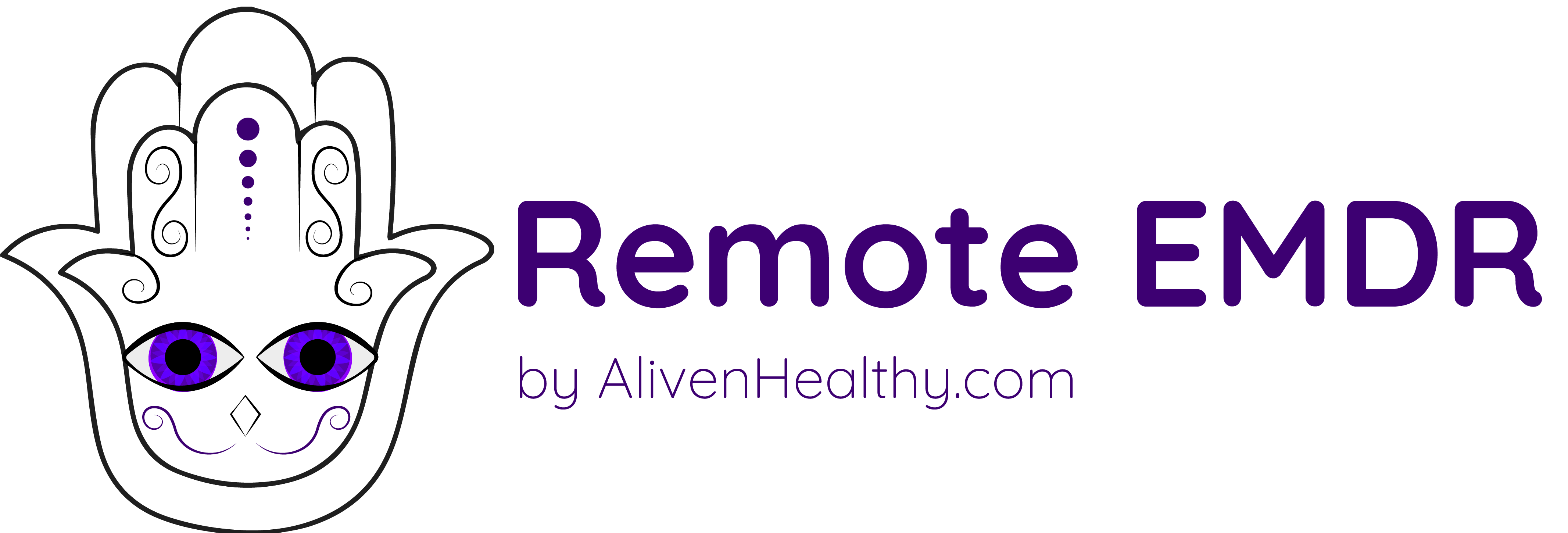EMDR Using Internal Family Systems and The Model of Parts and Sub-Personalities

Eye Movement Desensitization and Reprocessing / EMDR is a powerful, yet elegantly simple way to release trauma by helping to move traumatic right-brain material out of the autonomic nervous system and into the left-brain of logic, meaning, and narrative memory. Classical EMDR requires that people follow a complex set of instructions to locate internal trauma and then release it, but when working with EMDR online, these complex instructions can make it difficult for people to successfully release trauma at home without a trained therapist to guide them.
For this reason, we’ve developed a simpler model that people can use to release trauma using EMDR online at home. Most people intuitively understand the concept of having “parts” and can use this concept to easily identify internal conflict that is causing discomfort.
How to Use EMDR at Home: Internal Family Systems Basics
To reduce the complexity of instructions for EMDR, we use the Internal Family System model that was developed by Dr. Richard Schwartz. A similar model has been used for decades by hypnotherapists working with sub-personalities and introjects. According to this model, the mind is made up of “parts” that develop in response to trauma. These parts of us are sub-personalities that we embody throughout the day and at specific times to confront situations that challenge us. All of us have a core personality that exists inside of us like an ideal parent. This core personality is wise, compassionate, and curious. It functions, in part, to manage the sub-personalities that are generally young, childlike parts that were damaged by trauma in the early years of our lives. These parts of us become a repository of trauma if they are not properly cared for and acknowledged by our Core Self.
Click here to buy the book No Bad Parts by Dr. Richard Schwartz.
When a person has been overwhelmed by trauma (either one big trauma or ongoing traumatic experiences), there are many sub-personalities that may try to take control of the body when we face situations that challenge us. These sub-personalities feel internal conflict with each other and they are often a source of toxic thoughts.
Everyone has sub-personalities. Most healthy people have about 15 sub-personalities, but in people with unresolved trauma, these sub-personalities are not fully integrated. In other words, the sub-personalities have not come to an agreement and and understanding with each other. One sub-personality, let’s say, the sub-personality that you use to talk to your boss at work, may hate the part of you that just wants to go home, relax, and read a book. This work-related sub-personality may have lots of hateful thoughts that you notice whenever you sit down to relax on a weekend. These hateful thoughts are a manifestation of some kind of unresolved trauma and inner conflict.
Most people intuitively understand the Internal Family Systems model because they’re familiar with the inner chatter of different voices that have strong feelings about what they’re doing or not doing. The inner chatter often involves conflicted emotions as each sub-personality deals with and absorbs the trauma or stress of specific situations in your life. Some sub-personalities are destructive and they may cause problems in your work or in your relationships. This can be an ongoing source of frustration to say the least.
Click here to do a free trial of EMDR online.
There are No Bad Sub-Personalities
All of the sub-personalities that exist as a result of trauma are there to protect you. Often, there is a weaker part that has been cast away and that barely has a voice. This part, an Exile, often absorbs the bulk of trauma and stress in certain situations. On the other hand, there are also sub-personalities that act as Protectors. These sub-personalities are often the most vocal in terms of inner chatter. They are also often a source of toxic thoughts. But they’re always there to protect you from behaviors or situations that might lead to more trauma or negative outcomes. For this reason, it’s vital that you have compassion for all of your sub-personalities, even the ones that are creating toxic thoughts, because they all have a purpose and they all want for you to take control, using a tool like EMDR to help the Core Self step forward, to resolve the internal conflict permanently so that these various sub-personalities can begin to contribute to your life in positive, constructive ways.
Embody a Sub-Personality
EMDR seeks to resolve the internal conflicts between different sub-personalities. If you have an internal conflict that you’ve noticed in the form of internal chatter, toxic thoughts, or negative memories that are being served up by one of these sub-personalities you begin your EMDR session by pulling this personality forward to embody it fully and feel the feelings associated with those negative thoughts, the chatter, or memories. Try to amplify the feeling of this sub-personality and tune into the internal chatter rather than trying to make it stop and then begin the eye movements. It may help to imagine this sub-personality in your mind and ask it to step forward so that you can hear what it has to say.
It can also be helpful to set up your computer or device in front of two chairs that are facing the computer. Each chair represents a point-of-view that you have in regard to the internal chatter and toxic thoughts or memories. For example, you may have an inner voice that says negative things to you when you are trying to buy something that you really want, but you actually have two perspectives or rather, two sub-personalities that are in conflict with each other in a situation like this. While one sub-personality wants something badly (an item, experience, service, etc.), another sub-personality is trying to protect You (the Core Self) from something else (going broke, spending your money on something the rest of your sub-personalities do NOT want, etc)..
Begin the Online EMDR Session: 2-3 minutes
In a situation like this, you can use EMDR to help these two sub-personalities talk to each other and come to an understanding. Begin by sitting in one chair and tuning in to the internal chatter, memories or emotions associated with, in our example, getting something you really want. Do 2-3 minutes of EMDR and as your eyes are moving, try to amplify the emotions associated with getting something you really want. At some point during the 2-3 minute eye movement, your mind may wander and your emotions may change. Allow this to happen naturally.
Switch to the Other Sub-Personality
At the end of the 2-3 minute session, imagine the situation that gives you conflict internally. In our example, this would be the act of buying / getting something you really want for yourself. If you still have toxic thoughts, new memories, or strong negative emotions, switch to the other chair and imagine that you are embodying the sub-personality that has negative things to say about buying something that you want.
Be curious about this part and allow it to speak to you and tell you why it has such strong, negative feelings and thoughts. As soon as you feel this sub-personality’s point of view or see this sub-personality in your mind’s eye, begin another EMDR session that lasts 2-3 minutes.
Essentially, you are allowing yourself to hear both sides of your own internal conflict with an open, curious, and compassionate mind. Imagine that one part of you is sitting in one chair and the other part of you is sitting in the other chair. Ask your Core Self, the part of you that is wise and fair to simply observe this EMDR session, like a parent who is hearing both sides of a story from siblings who have been fighting with each other.
Continue…
Continue this process of switching chairs for each 2-3 minute session doing EMDR. Do up to 10 rounds of EMDR with breaks of a couple of minutes in between each session until you begin to feel the conflict release.
Listen to Other Sub-Personalities
After you complete the process of doing EMDR on two sub-personalities with strong feelings for or against a particular situation or aspect of yourself, you may notice other “voices” or some new conflicted thoughts that bubble to the surface. Often, there are several sub-personalities that are created to manage trauma and while there may be strong polarized views between two sub-personalities that are most noticeable, in fact, there may be 3-5 sub-personalities that are involved in managing unresolved trauma.
It’s important that you come back to the online EMDR program and use it again if you begin to notice new toxic thoughts, painful or strange memories, or uncomfortable emotions after you work with EMDR initially. It’s common for people to have to do multiple sessions of EMDR over the course of several days or even several weeks to release trauma using this type of therapy.
Brain Entrainment and Guided Meditation
Some people find that it’s helpful to work with brain entrainment and guided meditation between EMDR sessions to practice going into alpha and theta brain wave states that are conducive to the release of trauma. People who are carrying a lot of trauma may have a hard time getting into an alpha or theta brainwave state, but getting into this state of mind is something that you can practice using tools or by working with a trained hypnotherapist. Like flexing a muscle, the more you practice being in an alpha or theta brainwave state, the easier it gets to find these states of mind. The DreamLight.app is an entrainment and guided meditation tool that fosters relaxed, but focused states of mind using music and flashing lights. Guided meditations are optional with this tool and can be used to accomplish specific goals using the power of the unconscious mind.
If you work with a brain entrainment tool like DreamLight.app between online EMDR sessions, it will give you better access to content that is creating internal conflict on an unconscious level. The DreamLight.app like EMDR online, is also a trauma-release app, but these two tech-based therapies complement each other very well. While EMDR requires more conscious Intention, DreamLight.app is a more passive experience that allows a person to relax and gain access to what is troubling within a calm and emotionally safe context.
Click here to learn more about the DreamLight.app, a guided meditation and brain-entrainment tool.
Online EMDR: Private Sessions
Working with an EMDR therapist online, especially initially when you first start using this tool at home, can help you get better results. Click here to learn more about how to set up a private EMDR session online.






